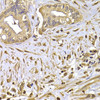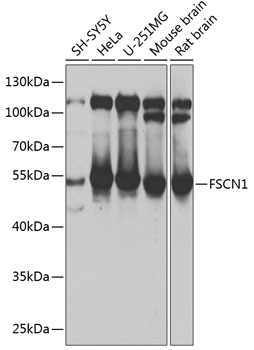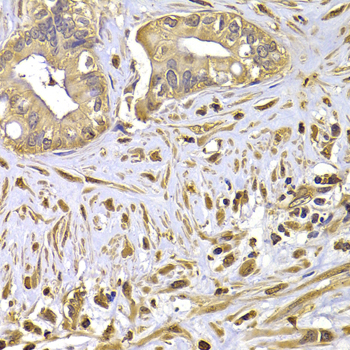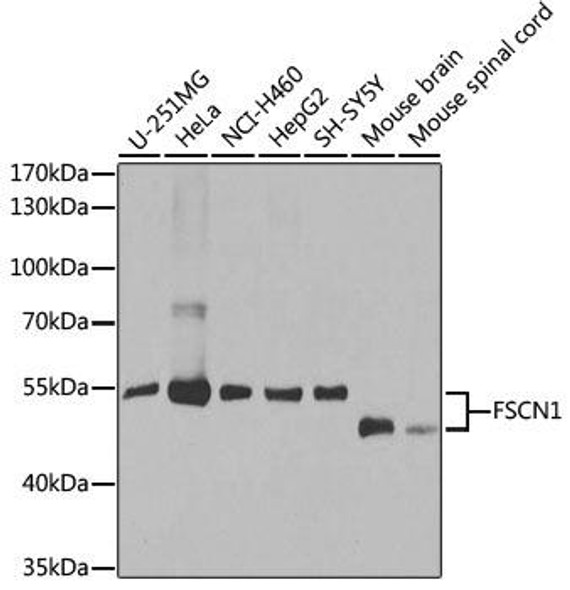Description
Anti-FSCN1 Antibody (CAB13355)
The FSCN1 Polyclonal Antibody (CAB13355) is a valuable tool for researchers studying the FSCN1 protein, which plays a key role in regulating cell morphology and motility. This antibody, generated in rabbits, exhibits high reactivity with human samples and is validated for use in Western blot applications. By binding specifically to FSCN1, researchers can detect and analyze the protein in various cell types, making it ideal for studies in cell biology, cancer research, and developmental biology.
FSCN1, also known as fascin, is a crucial regulator of actin bundling and cell migration, making it a key player in processes such as cell adhesion and invasion. Its involvement in promoting tumor progression and metastasis highlights its potential as a therapeutic target for cancer treatment. Research into the function and regulation of FSCN1 is essential for advancing our understanding of cancer biology and developing targeted therapies to combat the disease.
| Antibody Name: | Anti-FSCN1 Antibody |
| Antibody SKU: | CAB13355 |
| Antibody Size: | 20uL, 50uL, 100uL |
| Application: | WB IHC |
| Reactivity: | Human, Mouse, Rat |
| Host Species: | Rabbit |
| Immunogen: | Recombinant fusion protein containing a sequence corresponding to amino acids 260-380 of human FSCN1 (NP_003079.1). |
| Application: | WB IHC |
| Recommended Dilution: | WB 1:500 - 1:2000 IHC 1:50 - 1:200 |
| Reactivity: | Human, Mouse, Rat |
| Positive Samples: | SH-SY5Y, HeLa, U-251MG, Mouse brain, Rat brain |
| Immunogen: | Recombinant fusion protein containing a sequence corresponding to amino acids 260-380 of human FSCN1 (NP_003079.1). |
| Purification Method: | Affinity purification |
| Storage Buffer: | Store at -20'C. Avoid freeze / thaw cycles. Buffer: PBS with 0.02% sodium azide, 50% glycerol, pH7.3. |
| Isotype: | IgG |
| Sequence: | CAQV VLQA ANER NVST RQGM DLSA NQDE ETDQ ETFQ LEID RDTK KCAF RTHT GKYW TLTA TGGV QSTA SSKN ASCY FDIE WRDR RITL RASN GKFV TSKK NGQL AASV ETAG DSEL FLMK L |
| Gene ID: | 6624 |
| Uniprot: | Q16658 |
| Cellular Location: | Cell junction, Cell projection, Cytoplasm, cytoskeleton, cytosol, filopodium, invadopodium, microvillus |
| Calculated MW: | 54kDa |
| Observed MW: | 55kDa |
| Synonyms: | FSCN1, FAN1, HSN, SNL, p55, fascin |
| Background: | This gene encodes a member of the fascin family of actin-binding proteins. Fascin proteins organize F-actin into parallel bundles, and are required for the formation of actin-based cellular protrusions. The encoded protein plays a critical role in cell migration, motility, adhesion and cellular interactions. Expression of this gene is known to be regulated by several microRNAs, and overexpression of this gene may play a role in the metastasis of multiple types of cancer by increasing cell motility. Expression of this gene is also a marker for Reed-Sternberg cells in Hodgkin's lymphoma. A pseudogene of this gene is located on the long arm of chromosome 15. |
| UniProt Protein Function: | Fascin: Organizes filamentous actin into bundles with a minimum of 4.1:1 actin/fascin ratio. Plays a role in the organization of actin filament bundles and the formation of microspikes, membrane ruffles, and stress fibers. Important for the formation of a diverse set of cell protrusions, such as filopodia, and for cell motility and migration. Associates with beta-catenin. Ubiquitous. Belongs to the fascin family. |
| UniProt Protein Details: | Protein type:Motility/polarity/chemotaxis; Cytoskeletal; Actin-binding Chromosomal Location of Human Ortholog: 7p22 Cellular Component: cytoplasm; stress fiber; cell junction; cytosol; actin cytoskeleton; filopodium Molecular Function:protein binding, bridging; actin filament binding; protein binding; drug binding; actin binding Biological Process: cell proliferation; actin filament bundle formation; cell migration; cell motility involved in cell locomotion; actin cytoskeleton organization and biogenesis |
| NCBI Summary: | This gene encodes a member of the fascin family of actin-binding proteins. Fascin proteins organize F-actin into parallel bundles, and are required for the formation of actin-based cellular protrusions. The encoded protein plays a critical role in cell migration, motility, adhesion and cellular interactions. Expression of this gene is known to be regulated by several microRNAs, and overexpression of this gene may play a role in the metastasis of multiple types of cancer by increasing cell motility. Expression of this gene is also a marker for Reed-Sternberg cells in Hodgkin's lymphoma. A pseudogene of this gene is located on the long arm of chromosome 15. [provided by RefSeq, Sep 2011] |
| UniProt Code: | Q16658 |
| NCBI GenInfo Identifier: | 2498357 |
| NCBI Gene ID: | 6624 |
| NCBI Accession: | Q16658.3 |
| UniProt Related Accession: | Q16658 |
| Molecular Weight: | 54kDa |
| NCBI Full Name: | Fascin |
| NCBI Synonym Full Names: | fascin actin-bundling protein 1 |
| NCBI Official Symbol: | FSCN1 |
| NCBI Official Synonym Symbols: | HSN; SNL; p55; FAN1 |
| NCBI Protein Information: | fascin |
| UniProt Protein Name: | Fascin |
| UniProt Synonym Protein Names: | 55 kDa actin-bundling protein; Singed-like protein; p55 |
| Protein Family: | Fascin |
| UniProt Gene Name: | FSCN1 |
| UniProt Entry Name: | FSCN1_HUMAN |












